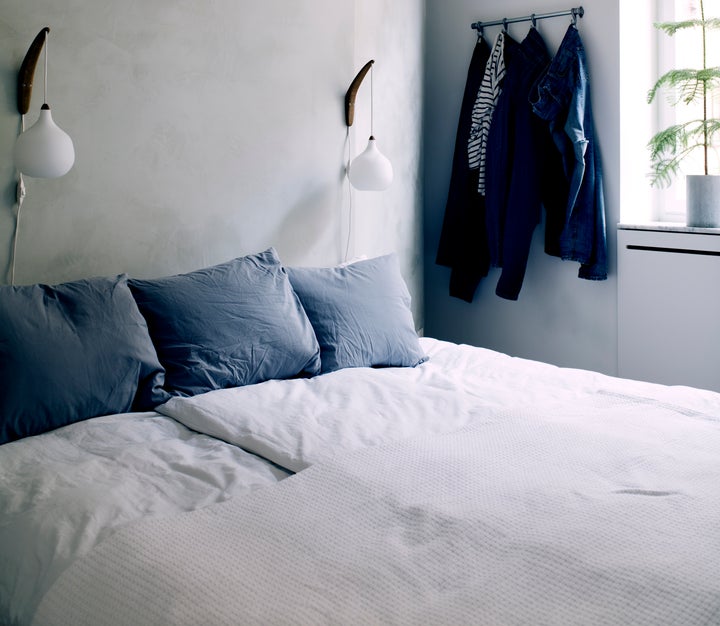
Sharing a bed with your partner can be sweet and cozy. But if you’re not compatible bedmates, it’s more frustrating than anything else. Your sleep suffers and resentment toward your partner can build.
A simple change to the way we make our beds — inspired by a common Scandinavian practice — could be the key to a better night’s sleep. Many folks in countries like Sweden, Denmark and Norway and in other parts of Europe use a two-duvet system. So instead of sharing one big duvet, each partner has their own separate, smaller comforter.
“This is also known as ‘The Scandinavian method’ as it is standard procedure in the Scandinavian countries,” Li Åslund, a Swedish clinical psychologist and sleep expert at Sleep Cycle, told HuffPost. “In fact, it is much harder to find duvet covers for double-size duvets in this part of the world.”
“A large majority of households has never even reflected on the fact that people in other countries might find this practice surprising or even weird,” she added.
The Scandinavian method got some buzz recently when photographer and content creator Cecilia Blomdahl, who is originally from Sweden but lives on the Arctic island of Svalbard, posted about it on her TikTok. The video has since amassed more than 1.1 million views and almost 700 comments.
“Yes, we have two duvets here and I could never live with one,” Blomdahl says in the video as she makes her bed.
One of the main benefits of using two duvets? Temperature regulation. Each partner can adjust their side to suit their individual preferences, Åslund said. So if you run hot but your partner runs cold, you can choose a lightweight comforter and your partner can use a heavier one.
Another plus of the Scandinavian method: fewer sleep disturbances. That’s good news if you share a bed with someone who steals the covers.
“Each partner’s movements will be less disruptive to the other’s, reducing the number of unnecessary awakenings, including the ones people don’t remember but may nevertheless decrease sleep quality,” Jade Wu — a behavioral sleep medicine specialist and sleep researcher at Duke University School of Medicine — told HuffPost.
Martin Seeley, CEO and sleep expert at MattressNextDay, says he recommends doubling up on duvets for just that reason.
“I would recommend it to anyone who shares a bed with someone and who lives in a cooler climate,” he told HuffPost. “If the duvet slips off or one person hogs it by accident, this can cause disturbance to your sleep and you may find you are waking up more often due to becoming cold in the night.”

Getting quality sleep is associated with a number of health benefits: improved immune system and cognitive function, better mood, and decreased stress and risk for chronic disease. It can also be a boon to your relationship.
“When we’re sleeping better, we are better at regulating emotions and making sound decisions — both very important for having a good relationship,” Wu said. “When we feel and function better, we have more emotional resources to devote to our partners. But when we are exhausted, foggy, or irritable, it’s easy to butt heads over little things or miscommunicate; it’s also harder for us to be attentive and supportive.”
There are a couple of potential drawbacks to the Scandinavian method. One concern is that two duvets don’t always have the cohesive, aesthetically pleasing look of one. With this approach, each duvet is typically folded in half length-wise, then you lay them next to each other (though you can also try laying them flat and overlapping them a bit).
To unify the look, you can put a bedspread over top of both (like Blomdahl did) or lay a throw across the bottom of the bed. Adding a long bolster pillow along with your other decorative pillows can also help bring it all together.
The individuality of the Scandinavian method could be a downside for some couples, Åslund said. They might find it less romantic or feel less connected not being under the same blanket at night.
“The Scandinavian countries are known for their pragmatic view on family life and their individuality, and the separate duvets can be considered a manifestation of these values,” she said. “For people in other countries, choosing personal comfort over physical closeness can feel uncomfortable and bringing up the subject in a relationship could be a potential source of conflict.”
At the end of the day, it’s up to you and your partner to find a system that works for you.
“Even though the practice entails many individual benefits when it comes to sleep quality, it’s worth noting that separate duvets might not be for all couples and it’s a matter of personal preference,” Åslund said.